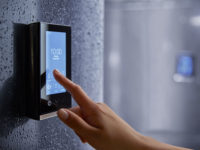Showers reign in master bathroom remodels

Photo by Christian Mackie on Unsplash
Master bathrooms are making extra space for showers, according to the 2019 U.S. Houzz Bathroom Trends Study. Four in five homeowners upgrade their shower during master bathroom renovations (83%) and more than half increase their shower size (54%). This is particularly notable when considering that only 22% expand their master bathroom square footage during renovations.
For many master bathroom renovators, shower expansion alleviates the pre-project pet peeve of a small shower (38%), which is second only to having an outdated space (59%). In addition, 24% of renovating homeowners remove their master tub and more than four in five of those choose to enlarge the shower in its place (84%).
Homeowners are making substantial investments on their master bathroom renovations. The space commands the second highest median spend in home remodels at $8,000 nationally, a 14% year-over-year increase from 2017 to 2018. Median spend also increased for major master bathroom remodels, from $10,100 to $12,000, respectively, as well as for minor remodels, from $2,000 to $2,300, respectively.* Among the top 50 U.S. metropolitan areas by population, San Francisco and San Jose have the highest median spend on master bathroom remodels ($15,000 and $13,000, respectively), while Orlando has the lowest ($3,760).
“Bathrooms have always been a top room to renovate, along with kitchens, and now we’re seeing homeowners double down on their master bathrooms,” said Nino Sitchinava, Houzz principal economist. “The cost of materials including stone and tile has increased due to trade disputes, driving up master bathroom spend. Despite this, renovation activity remains strong, propped by high home equities and homeowners’ desire to stay put given the limited housing supply.”
Nearly half of renovating homeowners report that they relax in their bathrooms (45%). Cleanliness and lack of clutter are key to creating a relaxing sanctuary (68% and 60%, respectively), among those who relax in their bathroom. To achieve an organized oasis, master bathroom renovators are upgrading their vanity (77%), medicine cabinet and other cabinets (each 31%). Neutral tones help to further the spa-like feel with white or wood vanities (34% and 29%, respectively), white counters (46%), gray or white flooring (31% and 19%, respectively), and gray or white walls (29% and 27%, respectively). Also, among those who added or replaced their bathtub, popularity of freestanding flat-bottom tubs grew from 41% in 2017 to 50% in 2019.
Additional bathroom trends from the study include:
• Styles go transitional, modern: Among those changing the style of their master bathroom, transitional and modern styles are gaining popularity, both increasing by five percentage points to 21% and 20%, respectively. Contemporary style continues a three-year decline from 23% in 2017 to 16% in 2019. Less than one in ten choose traditional style (9% in 2019, down from 14% in 2018). While farmhouse style climbed the ranks to 7% in 2018, just 4% of master bathroom renovators chose this style in 2019.
• Accent walls abound: More than one-third of renovating homeowners add an accent wall during their master bathroom renovation (35%), either in the shower (15%) or outside it (20%). Patterns are the most common differentiator (51%), followed by different surface materials (44%), color (40%) and texture (35%). That said, over half of accent walls appear in neutral palettes of gray (22%), blue (16%) or white (15%), with 16% choosing a more bold, multi-colored accent wall.
• A moment for medicine cabinets: When upgrading their medicine cabinet during master bath renovations, two in five homeowners opt for custom or semi-custom medicine cabinets to fit their needs (40%). Two-thirds of upgraded medicine cabinets have mirrors on the outside (67%) and a third have them on the inside (34%). Homeowners updating their medicine cabinets also opt for specialty features like lighting on the outside (18%), hidden plugs (17%) and anti-fog systems (12%).
• Mirror, mirror on the wall: Three in four homeowners replace their mirror during master bathroom renovations (77%). They typically opt for two mirrors (54%), likely to match the increasingly common two sinks (69% in 2019, up from 66% in 2018). Top features in mirrors include anti-fog systems (15%), LED lighting (14%) and hidden plugs (6%).
• More techy toilets: One-third of upgraded master bathroom toilets have high-tech features (34%), up from 28% in 2018. Top features include self-cleaning and seats with bidets (each 13%), heated seats (10%), overflow protection (9%) and built-in nightlights (8%).
• Fresh light: Four in five renovating homeowners update their lighting during renovations (81%) including wall lights, recessed lights and shower lights (59%, 55% and 38%, respectively). Many also opt for decorative touches in chandeliers (17%) and pendant lights (15%). The majority of new lights feature a combination of metal and glass (70%), but a surprising 19% of new lights are all metal.
• Alternative flooring options: Ceramic/porcelain tile continues to be the most popular flooring material both inside and outside the shower, among renovating homeowners updating flooring in these two spaces. The popularity of natural stone in flooring outside showers is on the decline (25% in 2019, down from 30% in 2017). Instead, new flooring materials such as vinyl/resilient and engineered wood flooring materials are on the rise (combined 10%, up from 6% in 2017).
The hiring of professional help has remained stable in recent years (83%). However, renovating homeowners are increasingly likely to hire bathroom specialists including bathroom remodelers (20% in 2019, up from 17% in 2017) and bathroom designers (14% in 2019, up from 12% in 2017).
You can download the full 2019 U.S. Houzz Bathroom Trends Study here.
The “U.S. Bathroom Trends Study” is an online survey fielded to U.S. Houzz users between June and July 2019. n=1,360.
*A major remodel is defined as a remodel where a homeowner upgrades at least the shower area; a minor remodel does not include a shower upgrade.
Looking for a reprint of this article?
From high-res PDFs to custom plaques, order your copy today!





